Sold for (Inc. bp): £2,340
Restrung necklace of tubular and fusiform carnelian beads with annular spacers; drum-shaped dangles each with an incuse motif to the underside. 78 grams, 53 cm long
Acquired before 1983.
Ex London gallery, 1990s.
This lot has been checked against the Interpol Database of stolen works of art and is accompanied by a search certificate number no.12537-231965.
This lot has been cleared against the Art Loss Register database, and is accompanied by an illustrated lot declaration signed by the Head of the Antiquities Department, Dr Raffaele D'Amato.
Cylinder with cord and bead handles; accompanied by a copy of an old scholarly note, typed and signed by W.G. Lambert, late Professor of Assyriology, University of Birmingham, 1970-1993, which states: 'Cylinder seal of fossil shell. 28 x 16 mm., condition good. Contest scene: standing hero succours reared up domestic animal on either side as they are attacked by lions, a second hero pulls the tail of the right-hand lion from behind; terminal scorpion below double line. This well known type of Sumerian seal occurs at the very end of the Early Dynastic periods, and on into the beginning of the Akkad dynasty. The scene involves divine heroes, and it was hoped that in actual life such figures would save domestic herds from attacks of lions.'; accompanied by a museum-quality impression. 14.9 grams total, 8.1-27.78 mm
UK private collection, acquired 1980-1983.
Accompanied by a copy of a scholarly note, typed and signed by Professor Wilfrid George Lambert in August 1990.
This lot has been cleared against the Art Loss Register database, and is accompanied by an illustrated lot declaration signed by the Head of the Antiquities Department, Dr Raffaele D'Amato.
Cylinder with cord and bead handles; accompanied by a copy of an old scholarly note, typed and signed by W.G. Lambert, late Professor of Assyriology, University of Birmingham, 1970-1993, which states: 'Cylinder seal of white marble, 32 x 19.5 mm., condition fair. Standing goddess with hand at waist, shoots growing from both sides of her body and her head; standing deity with head and wings of a bird, otherwise a human body, and holding in each hand the tail of a long-horned quadruped. From south-east Iran, c. 2900-2500 B.C. Little is known of the religion of this area, since no written information about it exists.'; accompanied by a museum-quality impression. 21.8 grams total, 8.1-32 mm
UK private collection, acquired 1980-1983.
Accompanied by a copy of a scholarly note, typed and signed by Professor Wilfrid George Lambert in September 1990.
This lot has been cleared against the Art Loss Register database, and is accompanied by an illustrated lot declaration signed by the Head of the Antiquities Department, Dr Raffaele D'Amato.
Cylinder with cord and bead handles; accompanied by a copy of an old scholarly note, typed and signed by W.G. Lambert, late Professor of Assyriology, University of Birmingham, 1970-1993, which states: 'Description of Cylinder Seal of Fossil Shell 30 x 16.5 mm. A god standing in the centre succours a domestic animal on either side which is being attack[ed] in turn by a lion. Terminal: two line[s] below vacant description panel. The seal is of late ED III or early Akkad date, c. 2400-2200 B.C. The cutting is marked by a strong use of the drill. The seal is worn, though the design clear. The meaning of the design is based on real life. Lions were a real threat to the herds and flocks of the community, and it was hoped that the depiction of a god coming to the rescue of the domestic creatures would mean that in real life their animals would be similarly saved by divine help.'; accompanied by a museum-quality impression. 16.1 grams total, 8.1-29.57 mm
UK private collection, acquired 1980-1983.
Accompanied by a copy of a scholarly note, typed and signed by Professor Wilfrid George Lambert in August 1990.
This lot has been cleared against the Art Loss Register database, and is accompanied by an illustrated lot declaration signed by the Head of the Antiquities Department, Dr Raffaele D'Amato.
Cylinder with cord and bead handles; accompanied by a copy of an old scholarly note, typed and signed by W.G. Lambert, late Professor of Assyriology, University of Birmingham, 1970-1993, which states: 'Cylinder Seal of Black Stone. 25 x 13 mm, condition good. Seated figure holding up cup facing standing figure with one arm raised high, ball-staff between them, solar disc above; two further standing human figures, and two sideways quadrupeds, tête bêche to each other. The design is placed between upper and lower rules. North-Syrian or Anatolian, c. 2000 B.C.'; accompanied by a museum-quality impression. 8.02 grams total, 8.1-25 mm
UK private collection, acquired 1980-1983.
Accompanied by a copy of a scholarly note, typed and signed by Professor Wilfrid George Lambert in November 1988.
This lot has been cleared against the Art Loss Register database, and is accompanied by an illustrated lot declaration signed by the Head of the Antiquities Department, Dr Raffaele D'Amato.
Cylinder with cord and bead handles; accompanied by a copy of an old scholarly note, typed and signed by W.G. Lambert, late Professor of Assyriology, University of Birmingham, 1970-1993, which states: 'Cylinder Seal of Faience, Cream, 29 x 14 mm. The area of the design is divided into a smaller upper and a larger lower register. In the upper register are three horned animals, two with their heads down browsing, the third recumbent with its head up. In the lower register there is a kneeling god holding up a dead horned animal by its hind leg; two standing figures (priests) with a stylized tree between them; and two facing sphynxes above a fallen horned animal. This seas belongs to the Mittani common style, c. 1500-1200 B.C., and is one of the better specimens of its type. It probably comes from Syria, though Mitanni seals are found also in Palestine, Anatolia and Northern Mesopotamia. This double register type seems to be restricted to Syria. The tree is a symbol of the storm god, Teshub, but it is not known which god is represented by the horned animal.'; accompanied by a museum-quality impression. 6.44 grams total, 8.1-28.8 mm
UK private collection, acquired 1980-1983.
Accompanied by a copy of a scholarly note, typed and signed by Professor Wilfrid George Lambert in August 1990.
This lot has been cleared against the Art Loss Register database, and is accompanied by an illustrated lot declaration signed by the Head of the Antiquities Department, Dr Raffaele D'Amato.
Cylinder with fractured upper end; accompanied by a copy of an old scholarly note, typed and signed by W.G. Lambert, late Professor of Assyriology, University of Birmingham, 1970-1993, which states: ' Cylinder Seal of Black Stone, 41.5 x 19.5 mm. This seal is cone-shaped -- narrower at the top than the bottom -- and is engraved both around the sides and on the bottom. The top is broken off, and this would have contained a hole for carrying on a string. Around the sides a row of four walking men is depicted. They are shown in schematized shape, especially the heads which are round blobs with a point at one side for the nose. Three hold rods in their raised hand, the fourth grips a branch with the aid of the figure walking in front of him. All four have three horizontal cuts across their bodies from waist to thighs, and in three cases something flows out behind ending in a curve at the end, perhaps intended as part of their dress, a ribbon for example. This frieze is contained within lines above and below. On the base appears a standing quadruped with a small head and long curving tail. This is an extremely rare type of cylinder-stamp seal, Levantine in origin, and dating from c. 1300-1000 B.C. It is larger than most cylinder seals. The closest parallel is in the collection of the Dukes of Northumberland, now in the Museum of Oriental Art, University of Durham, published in Iraq 41 (1979) p.33f. and pl.xii, no.110.'; accompanied by a museum-quality impression. 26.58 grams, 42 mm
UK private collection, acquired 1980-1983.
Accompanied by a copy of a scholarly note, typed and signed by Professor Wilfrid George Lambert in August 1991.
This lot has been cleared against the Art Loss Register database, and is accompanied by an illustrated lot declaration signed by the Head of the Antiquities Department, Dr Raffaele D'Amato.
Sold for (Inc. bp): £1,235
Frieze in three registers: two crouching gryphons facing each other on a hatched base; below, advancing ox; court scene with a profile figure seated on a dais holding a vessel and facing two advancing figures in robes with open front, one leg exposed; sapling scene-divider; supplied with a museum-quality impression. 3.41 grams, 19 mm
From the 'S' collection, acquired 1970-1990s.
The collection was seen and studied by W.G. Lambert, late Professor of Assyriology at the University of Birmingham, 1970-1993.
This lot has been cleared against the Art Loss Register database, and is accompanied by an illustrated lot declaration signed by the Head of the Antiquities Department, Dr Raffaele D'Amato.
Sold for (Inc. bp): £1,105
Cylinder with cord and bead handles; accompanied by a copy of an old scholarly note, typed and signed by W.G. Lambert, late Professor of Assyriology, University of Birmingham, 1970-1993, which states: 'Cylinder Seal of Black Stone, 27 x 10 mm. The design is very full: the central figure is standing, wearing a short garment reaching just above the knees and holding a spear in one raised hand, before him is a kneeling figure, then there are three quadrupeds, two more or less naturalistic, one with wings and a bird's head. There is also a heraldically placed bird and numerous lines and shapes to fill every vacant space. This seal is a rare Cypriot type, c.1300 B.C., from either Cyprus itself or the adjacent coastal lands of Asia Minor or Syria.'; accompanied by a museum-quality impression. 6.27 grams total, 8.2-27.3 mm
UK private collection, acquired 1980-1983.
Accompanied by a copy of a scholarly note, typed and signed by Professor Wilfrid George Lambert in July 1991.
This lot has been cleared against the Art Loss Register database, and is accompanied by an illustrated lot declaration signed by the Head of the Antiquities Department, Dr Raffaele D'Amato.
Columnar in form with two beads and a cord forming handles; accompanied by a copy of an old scholarly note, typed and signed by W.G. Lambert, late Professor of Assyriology, University of Birmingham, 1970-1993, which states: 'Cylinder Seal of Soft Black Stone, 19x10.5mm. The engraved area is divided into two registers by a notched band. In the upper, narrower register there is a row of nine human heads. Below is a row of various items: a mace; a sitting animal; a recumbent bull with a bird above its back; a wedge; a standing human with one hand raised; a recumbent horned quadruped with head turned back with combined sun and lunar crescent above it. This seal is Syro-Cappadocian, from c. 2000 B.C. For comparable seals cf. Briggs Buchanan, catalogue of Ancient Near Eastern Seals in the Ashmolean Museum, I, no. 849 and idem, early Near Eastern Seals in the Yale Babylonian Collection, no.1180.'; supplied with a museum-quality impression. 4.95 grams, 38 mm long
UK private collection, acquired 1980-1983.
Accompanied by a copy of a typed and signed scholarly note by the late W.G. Lambert, Professor of Assyriology at the University of Birmingham, 1970-1993, with reference no.1580.
This lot has been cleared against the Art Loss Register database, and is accompanied by an illustrated lot declaration signed by the Head of the Antiquities Department, Dr Raffaele D'Amato.
Cylinder with cord and bead handles; accompanied by a copy of an old scholarly note, typed and signed by W.G. Lambert, late Professor of Assyriology, University of Birmingham, 1970-1993, which states: 'Cylinder seal of Red Stone with Some Cream, 30x13mm. The scene shows two kneeling worshippers, one either side of a stylized sacred tree below a winged solar disc. The seal is cut entirely with one tool, the cutting sheel, which enabled the work to be done quickly. the seal is to be dated c.900-800 B.C. and seals of this type are generally considered to be Babylonian, though this is not completely certain: they may have been made in Syria and southern Anatolia. The hands of the worshippers are in a typically Assyrian pose: one raised, one extended, but this type of seal is not generally found at Assyrian sites. The solar disc represents the storm god. Though there is some wear on the stone, the design remains quite clear and sharp.'; accompanied by a museum-quality impression. 8.8 grams total, 8.1-29.5 mm
UK private collection, acquired 1980-1983.
Accompanied by a copy of a scholarly note, typed and signed by Professor Wilfrid George Lambert in August 1990.
This lot has been cleared against the Art Loss Register database, and is accompanied by an illustrated lot declaration signed by the Head of the Antiquities Department, Dr Raffaele D'Amato.
Sold for (Inc. bp): £3,640
Square in section, sides tapering to the pierced apex; sequence of four intaglio figures: female on a hatched seat offering food to a goose; advancing female with hair in a single braid to the rear, holding a bowl and alabastron; male in knee-length tunic with lion-skin hood, holding an inverted spear; advancing female with hair in a single braid to the rear, holding a wreath and flower; rhyton to the underside. 9.8 grams, 25 mm
Acquired 1970-1999.
London collection of the late Mr S.M., thence by descent.
This lot has been checked against the Interpol Database of stolen works of art and is accompanied by a search certificate number no.12540-231460.
This lot has been cleared against the Art Loss Register database, and is accompanied by an illustrated lot declaration signed by the Head of the Antiquities Department, Dr Raffaele D'Amato.

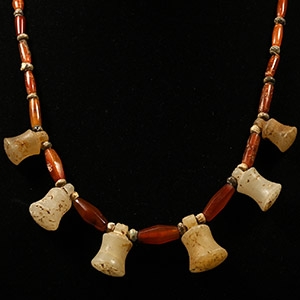
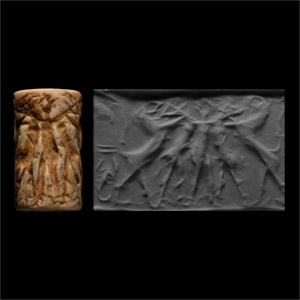
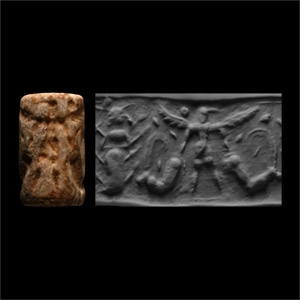

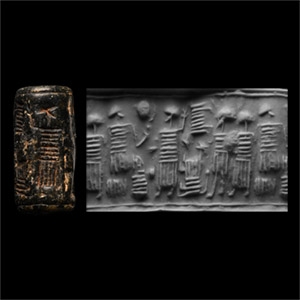
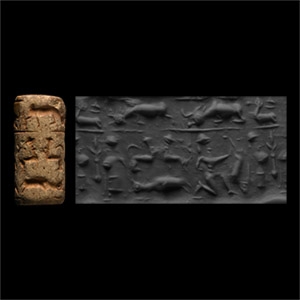
.jpg)
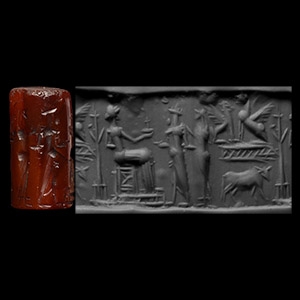
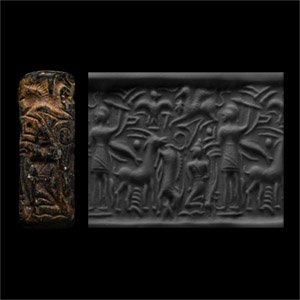
.jpg)
.jpg)
.jpg)



